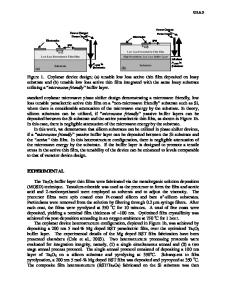Preparation and Characterization of Ba 1-x Sr x TiO 3 Based Thin Films for Pyroelectric Applications
- PDF / 722,105 Bytes
- 6 Pages / 612 x 792 pts (letter) Page_size
- 90 Downloads / 408 Views
C11.46.1
Preparation and Characterization of Ba1-xSrxTiO3 Based Thin Films for Pyroelectric Applications C.W. Hubbard, M.W.Cole, M. Ervin and M. Wood U.S. Army Research Laboratory, weapons and Materials Research Directorate Aberdeen Proving Ground, MD 21005 Abstract The use of pyroelectric thin films in uncooled IR detectors has many advantages over the present IR detector technology, which requires extensive cooling for operation. These advantages include reduced weight, reduced footprint, reduced complexity, increased reliability, and decreased maintenance. Ba1-xSrxTiO3 (BST), based thin films are ideal candidates for use in these devices due to their tailorable materials properties. These properties include a high dielectric constant, low dielectric loss, high electrical resistivity, as well as a high pyroelectric constant. BST thin films were doped with Mg in varying amounts, from 0 to 20mol%. The thin films were deposited via metalorganic solution deposition (MOSD) on Pt/Ti/SiO2/Si substrates. Annealing temperatures ranged from 500 to 750 0C. The films were characterized for structural, microstructural, compositional, surface morphological, dielectric and insulating properties. Glancing angle x-ray diffraction (GAXRD) was used to determine crystallinity, phase formation and film orientation. Field emission scanning electron microscopy (FESEM) and cross sectional transmission electron microscopy (TEM) were employed to access surface morphology and microstructure. The Materials Detectivity Figure of Merit (FOM), D*, [D*=pi/( CV(ε0εrtanδ)1/2 ] was used to evaluate the film’s detectivity response. Our results show that undoped Ba60Sr40TiO3, with a value D*= 0.08 (cm3/J)1/2, appears to out perform Pb based pyroelectric thin films, thus making it a viable candidate for IR pyroelectric detector applications. Introduction The primary drive for IR detection and the associated thermal imaging equipment has been in the 3-5 µm and 8-14 µm wavebands, corresponding to atmospheric windows of low absorption and also to thermal blackbody maxima at around room temperature. The development of uncooled thermal detectors, particularly based on the use of pyroelectric ceramic materials, will offer significant advantages in comparison with the cooled photon detector technology. The majority of photon detectors utilize photoconductive mercury cadmium telluride (MCT) as detector material; however, III-V compound semiconductor superlattices (GaAs/AlGaAs) are also being actively developed. Photon detectors require a cooling system to operate at a temperature where it exhibits maximum detectivity. The cooling system adds increased size and weight, and adds undesirable maintenance, and reliability issues to the detector design. Additionally, the various cooling systems are not versatile and have limits in terms of cooling temperature range that can be achieved. Electroceramic-ferroelectric materials possess a number of properties, which make them very important for use in pyroelectric sensors/detectors. These properties include: 1) a high
Data Loading...











